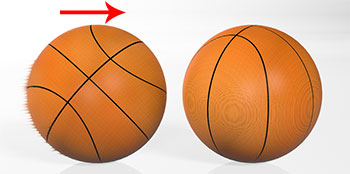Learn

Momentum
Momentum is way to refer to the quantity of motion that an object has. Basically, all objects have a mass, and if that mass is in motion, the object also has momentum.
Momentum depends on two main variables — mass and velocity. So, another way to define momentum is to say that momentum is the product of an object's mass in kg multiplied by its velocity speed and direction .
We represent momentum with the following equation: p = m × v or p = mv
- p = momentum
- m = mass in kg
- v = velocity in m/s
Using this equation, the unit of measurement for moment is kg·m/s. You should also notice that momentum using velocity, which is a vector quantity has both magnitude and direction . This means momentum is also a vector quantity so when reporting momentum we must report:
- a magnitude,
- a unit, and
- a direction of motion.
The momentum of an object is always in the same direction as its velocity.
Watch GPB: Momentum and Impulse.

Calculations
Using the equation we learned in the first section of this lesson, we can actually calculate the momentum of an object.
Let's try using this equation to find momentum in the following scenario: A runner with a mass of 77 kg has a velocity of 9 m/s east. What is the runner's momentum?
- First, let's identify the known and unknown values.
- m = 77 kg
- v = 9 m/s E
- p = ?
- Next, enter the values into the problem and solve.
- p = mv
- p = (77 kg)(9 m/s)
- p = 693 kg·m/s
- Answer: The momentum of a runner with a mass of 77 kg and a velocity of 9 m/s east is 693 kg·m/s.
To learn more, read the Momentum page from Physics Classroom. Complete the Check Your Understanding questions you find as you read to review calculations involving momentum.

Conservation
Now that you know what momentum is, it's time to talk about the law of conservation of momentum. The law of conservation of momentum states that if there is no external force acting on a system, the total momentum of the system does not change. Now a system is simply whatever objects/things you are dealing with at the moment. The objects involved in the collision are the only ones that remain in the system. Remember, we mentioned this briefly before when we talked about external forces as forces that are outside of the system you are concerned with.

Let's take two basketballs for example: one is sitting still on the ground and one is rolling towards it. Obviously the two balls collide. The momentum of the two balls before the collision, and the momentum of the two balls after the collision is exactly the same. This is the law of the conservation of momentum.
Now notice, the two balls may have different momentums before and after the collisions but the sum of their momentums will not change. Any momentum that is lost by one ball is gained by the other ball, leading to an overall conservation of momentum.
Use the Try It in this lesson to practice calculating momentum. Make sure you understand the calculation before moving to the quiz which will review everything you have learned so far.
In the next two lessons we will look at how to calculate momentum changes in a system using the law of conservation of momentum.

